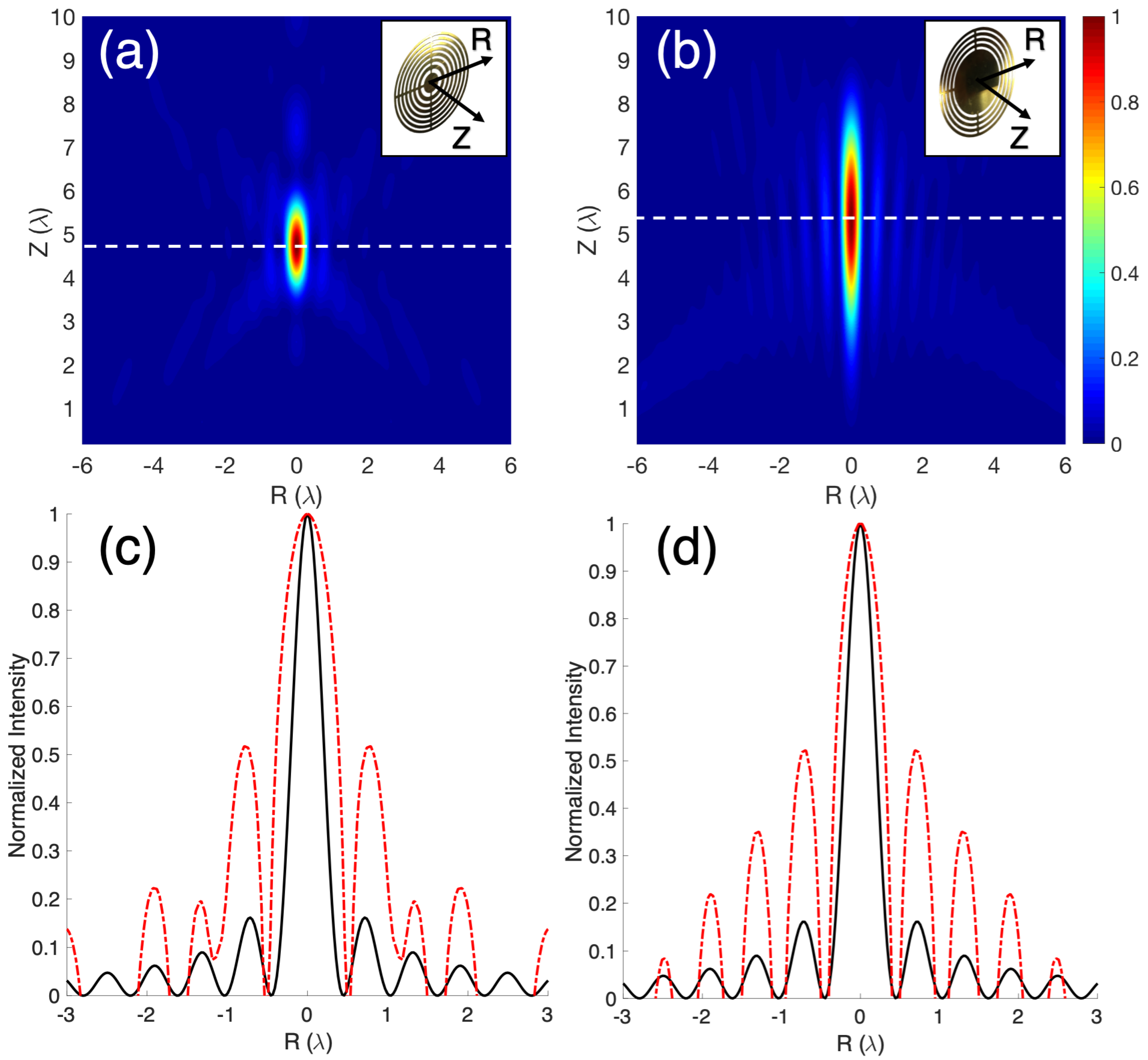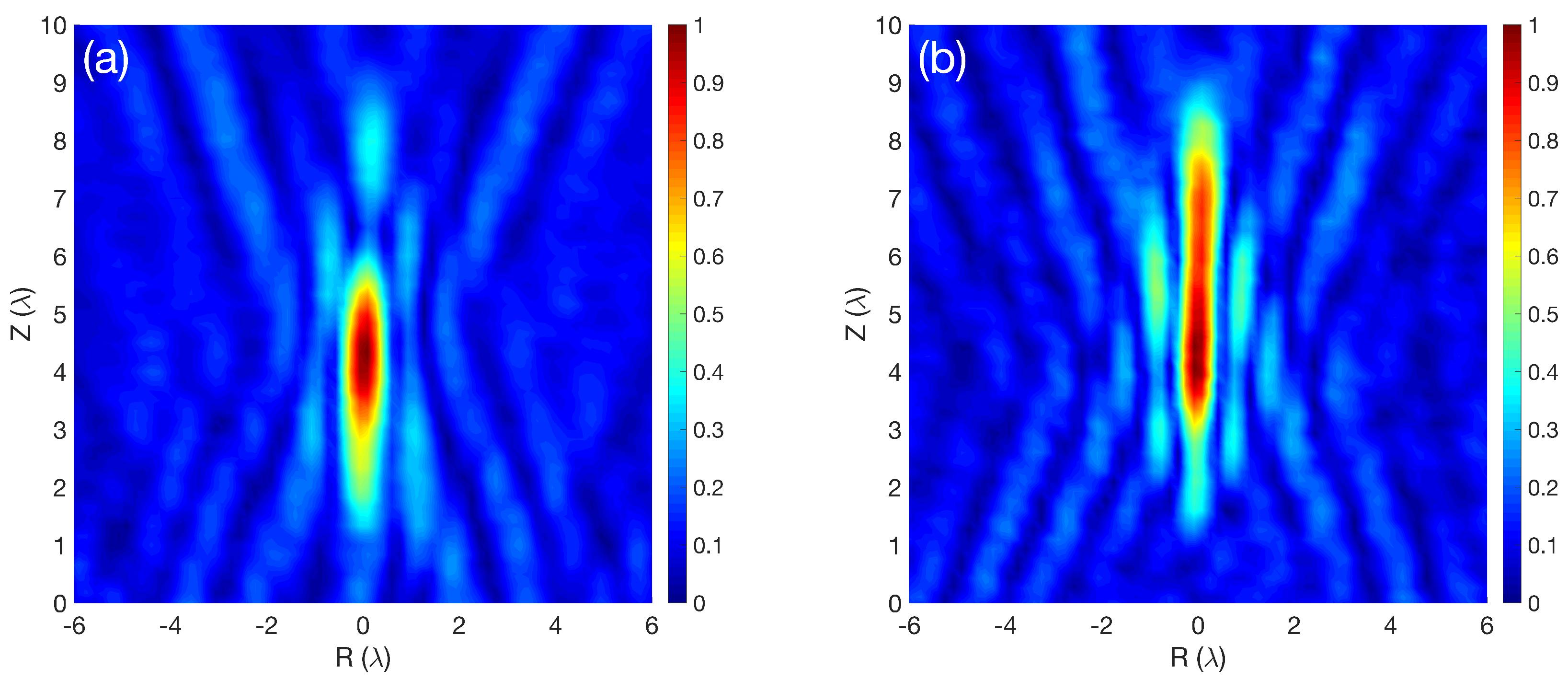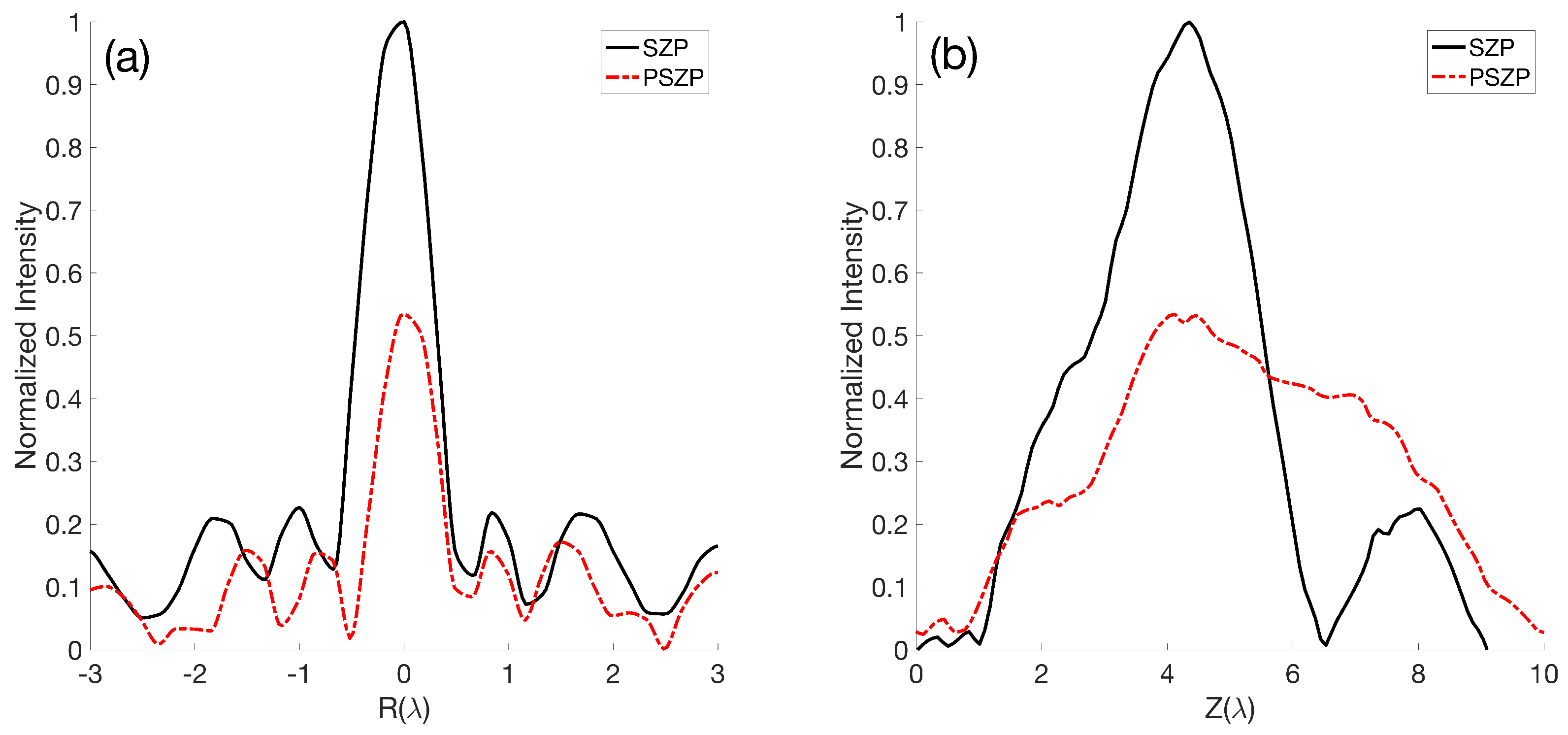Design of Acoustical Bessel-Like Beam Formation by a Pupil Masked Soret Zone Plate Lens
Abstract
1. Introduction
2. Mathematical Method and Simulations
3. Experimental Results
4. Conclusions
Author Contributions
Funding
Conflicts of Interest
References
- Pignoli, P.; Tremoli, E.; Poli, A.; Oreste, P.; Paoletti, R. Intimal plus medial thickness of the arterial wall: A direct measurement with ultrasound imaging. Circulation 1986, 74, 1399–1406. [Google Scholar] [CrossRef] [PubMed]
- Amemiya, I.; Yagi, H.; Mori, K.; Yamamoto, N.; Saitoh, S.; Tanuma, C.; Hirahara, S. Ink Jet Printing with Focused Ultrasonic Beams. Recent Progress in Ink Jet Technologies II; Society for Imaging Science and Technology: Springfield, VA, USA, 1999; Volume 5, pp. 274–279. [Google Scholar]
- McCann, D.; Forde, M. Review of NDT methods in the assessment of concrete and masonry structures. NDT E Int. 2001, 34. [Google Scholar] [CrossRef]
- Li, J.T.; Han, J.F.; Yang, J.H.; Li, T.S. An efficient synthesis of 3,4-dihydropyrimidin-2-ones catalyzed by NH2SO3H under ultrasound irradiation. Ultrason. Sonochem. 2003, 10, 119–122. [Google Scholar] [CrossRef]
- Albu, S.; Joyce, E.; Paniwnyk, L.; Lorimer, J.P.; Mason, T.J. Potential for the use of ultrasound in the extraction of antioxidants from Rosmarinus officinalis for the food and pharmaceutical industry. Ultrason. Sonochem. 2004, 11, 261–265. [Google Scholar] [CrossRef]
- Illing, R.; Kennedy, J.; Wu, F.; Ter Haar, G.; Protheroe, A.; Friend, P.; Gleeson, F.; Cranston, D.; Phillips, R.; Middleton, M. The safety and feasibility of extracorporeal high-intensity focused ultrasound (HIFU) for the treatment of liver and kidney tumours in a Western population. Br. J. Cancer 2005, 93, 890. [Google Scholar] [CrossRef] [PubMed]
- Vilkhu, K.; Mawson, R.; Simons, L.; Bates, D. Applications and opportunities for ultrasound assisted extraction in the food industry—A review. Innov. Food Sci. Emerg. Technol. 2008, 9, 161–169. [Google Scholar] [CrossRef]
- Schonbrun, E.; Rinzler, C.; Crozier, K.B. Microfabricated water immersion zone plate optical tweezer. Appl. Phys. Lett. 2008, 92, 071112. [Google Scholar] [CrossRef]
- Hon, S.; Kwok, K.; Li, H.; Ng, H. Self-focused acoustic ejectors for viscous liquids. Rev. Sci. Instrum. 2010, 81, 065102. [Google Scholar] [CrossRef]
- Calvo, D.C.; Thangawng, A.L.; Nicholas, M.; Layman, C.N. Thin Fresnel zone plate lenses for underwater acoustics: Modeling and experiments. In Proceedings of the OCEANS’15 MTS/IEEE, Washington, DC, USA, 19–22 October 2015. [Google Scholar]
- Tu, Y.L.; Chen, S.J.; Hwang, Y.R. Design of Fresnel Lens-Type Multi-Trapping Acoustic Tweezers. Sensors 2016, 16, 1973. [Google Scholar] [CrossRef]
- Welter, J.T.; Sathish, S.; Christensen, D.E.; Brodrick, P.G.; Heebl, J.D.; Cherry, M.R. Focusing of longitudinal ultrasonic waves in air with an aperiodic flat lens. J. Acoust. Soc. Am. 2011, 130, 2789–2796. [Google Scholar] [CrossRef]
- Li, Y.; Liang, B.; Tao, X.; Zhu, X.F.; Zou, X.Y.; Cheng, J.C. Acoustic focusing by coiling up space. Appl. Phys. Lett. 2012, 101. [Google Scholar] [CrossRef]
- Peng, P.; Xiao, B.; Wu, Y. Flat acoustic lens by acoustic grating with curled slits. Phys. Lett. A 2014, 378, 3389–3392. [Google Scholar] [CrossRef]
- Cervera, F.; Sanchis, L.; Sánchez-Pérez, J.V.; Martínez-Sala, R.; Rubio, C.; Meseguer, F.; López, C.; Caballero, D.; Sánchez-Dehesa, J. Refractive Acoustic Devices for Airborne Sound. Phys. Rev. Lett. 2002, 88, 023902. [Google Scholar] [CrossRef] [PubMed]
- Guenneau, S.; Movchan, A.; Pétursson, G.; Ramakrishna, S.A. Acoustic metamaterials for sound focusing and confinement. New J. Phys. 2007, 9. [Google Scholar] [CrossRef]
- Moleron, M.; Serra-Garcia, M.; Daraio, C. Acoustic Fresnel lenses with extraordinary transmission. Appl. Phys. Lett. 2014, 105. [Google Scholar] [CrossRef]
- Jang, J.; Chang, J.H. Design and fabrication of double-focused ultrasound transducers to achieve tight focusing. Sensors 2016, 16, 1248. [Google Scholar] [CrossRef] [PubMed]
- Hyun, J.; Kim, Y.T.; Doh, I.; Ahn, B.; Baik, K.; Kim, S.H. Realization of an ultrathin acoustic lens for subwavelength focusing in the megasonic range. Sci. Rep. 2018, 8, 9131. [Google Scholar] [CrossRef]
- Farnow, S.; Auld, B. Acoustic Fresnel zone plate transducers. Appl. Phys. Lett. 1974, 25, 681–682. [Google Scholar] [CrossRef]
- O’Shea, D.C.; Suleski, T.J.; Kathman, A.D.; Prather, D.W. Diffractive Optics: Design, Fabrication, and Test; Spie Press: Bellingham, WA, USA, 2004; Volume 62. [Google Scholar]
- Zhang, S.; Yin, L.; Fang, N. Focusing Ultrasound with an Acoustic Metamaterial Network. Phys. Rev. Lett. 2009, 102, 194301. [Google Scholar] [CrossRef]
- Soret, J. Ueber die durch Kreisgitter erzeugten Diffractionsphänomene. Ann. Phys. 1875, 232, 99–113. [Google Scholar] [CrossRef]
- Calvo, D.C.; Thangawng, A.L.; Nicholas, M.; Layman, C.N. Thin Fresnel zone plate lenses for focusing underwater sound. Appl. Phys. Lett. 2015, 107. [Google Scholar] [CrossRef]
- Bashford, A.G.; Schindel, D.W.; Hutchins, D.A.; Wright, W.M.D. Field characterization of an air-coupled micromachined ultrasonic capacitance transducer. J. Acoust. Soc. Am. 1997, 101, 315–322. [Google Scholar] [CrossRef]
- Kanevsky, I.N. Focusing of Sound and Ultrasound Waves; Nauka: Moscow, Russia, 1977. (In Rusian) [Google Scholar]
- Hiroshi, S.; Noriyoshi, C.; Jun Ichi, K. Acoustical Imaging; Plenum Press: New York, NY, USA, 1989. [Google Scholar]
- Minin, I.V.; Minin, O.V. Basic Principles of Fresnel Antenna Arrays; Springer Science & Business Media: Berlin, Germany, 2008; Volume 19. [Google Scholar]
- Born, M.; Wolf, E. Principles of Optics: Electromagnetic Theory of Propagation, Interference and Diffraction of Light; Elsevier: Amsterdam, The Netherlands, 2013. [Google Scholar]
- Minin, O.V.; Minin, I.V. Diffractive Optics of Millimeter Waves; IOP Publisher: London, UK, 2004. [Google Scholar]
- Minin, I.V.; Minin, O.V.; Gagnon, N.; Petosa, A. Investigation of the resolution of phase correcting Fresnel lenses with small focal length-to-diameter ratio and subwavelength focus. In Proceedings of the EMTS, Cracow, Poland, 10–12 September 2007; pp. 26–28. [Google Scholar]
- McGloin, D.; Dholakia, K. Bessel beams: Diffraction in a new light. Contemp. Phys. 2005, 46, 15–28. [Google Scholar] [CrossRef]
- Xu, Z.; Xu, W.; Qian, M.; Cheng, Q.; Liu, X. A flat acoustic lens to generate a Bessel-like beam. Ultrasonics 2017, 80, 66–71. [Google Scholar] [CrossRef] [PubMed]
- Hsu, D.K.; Margetan, F.J.; Thompson, D.O. Bessel beam ultrasonic transducer: Fabrication method and experimental results. Appl. Phys. Lett. 1989, 55, 2066–2068. [Google Scholar] [CrossRef]
- Lu, J.Y.; Greenleaf, J.F. A study of two-dimensional array transducers for limited diffraction beams. IEEE Trans. Ultrason. Ferroelectr. Freq. Control 1994, 41, 724–739. [Google Scholar] [CrossRef] [PubMed]
- Katchadjian, P.; Desimone, C.; Garcia, A. Application of axicon lenses in ultrasonic techniques. In Proceedings of the AIP 2010, Melville, NY, USA, 11 March 2010; Volume 1211, pp. 1043–1050. [Google Scholar] [CrossRef]
- Masuyama, H.; Yokoyama, T.; Nagai, K.; Mizutani, K. Generation of Bessel beam from equiamplitude-driven annular transducer array consisting of a few elements. Jpn. J. Appl. Phys. 1999, 38, 3080. [Google Scholar] [CrossRef]
- Masuyama, H.; Mizutani, K. Acoustic Beam Scanning Using Annular Transducer Array Introducing Decentering Operation. JSME Int J. Ser. C Mech. Syst. Mach. Elements Manuf. 2006, 49, 681–686. [Google Scholar] [CrossRef]
- Jimenez, N.; Romero-García, V.; Picó, R.; Cebrecos, A.; Sánchez-Morcillo, V.J.; Garcia-Raffi, L.; Sánchez-Pérez, J.V.; Staliunas, K. Acoustic Bessel-like beam formation by an axisymmetric grating. EPL (Eur. Lett.) 2014, 106, 24005. [Google Scholar] [CrossRef]
- Minin, I.V.; Minin, O.V. Control of focusing properties of diffraction elements. Sov. J. Quantum Electron. 1990, 20, 198. [Google Scholar] [CrossRef]
- Webb, G.; Minin, I.; Minin, O.V. New technique to suppress sidelobe clutter in perimeter security systems. Int. J. High Speed Electron. Syst. 2007, 17, 367–382. [Google Scholar] [CrossRef]
- Minin, I.V.; Minin, O.V. Reference phase in diffractive lens antennas: A review. J. Infrared Millim. Terahertz Waves 2011, 32, 801. [Google Scholar] [CrossRef]
- Tarrazó-Serrano, D.; Rubio, C.; Minin, O.V.; Candelas, P.; Minin, I.V. Manipulation of focal patterns in acoustic Soret type zone plate lens by using reference radius/phase effect. Ultrasonics 2019, 91, 237–241. [Google Scholar] [CrossRef] [PubMed]
- Clement, G.T.; Nomura, H.; Kamakura, T. Ultrasound Field Measurement Using a Binary Lens. IEEE Trans. Ultrason. Ferroelectr. Freq. Control 2015, 62, 350–359. [Google Scholar] [CrossRef] [PubMed]
- Fuster, J.M.; Candelas, P.; Castiñeira-Ibáñez, S.; Pérez-López, S.; Rubio, C. Analysis of Fresnel Zone Plates Focusing Dependence on Operating Frequency. Sensors 2017, 17, 2809. [Google Scholar] [CrossRef] [PubMed]
- COMSOL-Multiphysics. COMSOL-Multiphysics. COMSOL-Multiphysics User Guide (Version 4.3a). In COMSOL User Guide (Version 4.3a); COMSOL-Multiphysics: Shanghai, China, 2012; pp. 39–40. [Google Scholar]
- Qin, F.; Huang, K.; Wu, J.; Jiao, J.; Luo, X.; Qiu, C.; Hong, M. Shaping a subwavelength needle with ultra-long focal length by focusing azimuthally polarized light. Sci. Rep. 2015, 5, 9977. [Google Scholar] [CrossRef]
- Roy, T.; Rogers, E.T.; Yuan, G.; Zheludev, N.I. Point spread function of the optical needle super-oscillatory lens. Appl. Phys. Lett. 2014, 104, 231109. [Google Scholar] [CrossRef]
- Rubio, C.; Fuster, J.M.; Castiñeira-Ibáñez, S.; Uris, A.; Belmar, F.; Candelas, P. Pinhole Zone Plate Lens for Ultrasound Focusing. Sensors 2017, 17, 1690. [Google Scholar] [CrossRef]






| at −3 dB () | at −3 dB () | |
|---|---|---|
| SZP | 2.84 | 0.81 |
| PSZP | 5.94 | 0.64 |
| Bessel | - | 0.64 |
| at −3 dB () | at −3 dB () | |
|---|---|---|
| Experimental SZP | 3.51 | 0.79 |
| Experimental PSZP | 5.72 | 0.67 |
© 2019 by the authors. Licensee MDPI, Basel, Switzerland. This article is an open access article distributed under the terms and conditions of the Creative Commons Attribution (CC BY) license (http://creativecommons.org/licenses/by/4.0/).
Share and Cite
Tarrazó-Serrano, D.; Castiñeira-Ibáñez, S.; Minin, O.V.; Candelas, P.; Rubio, C.; Minin, I.V. Design of Acoustical Bessel-Like Beam Formation by a Pupil Masked Soret Zone Plate Lens. Sensors 2019, 19, 378. https://doi.org/10.3390/s19020378
Tarrazó-Serrano D, Castiñeira-Ibáñez S, Minin OV, Candelas P, Rubio C, Minin IV. Design of Acoustical Bessel-Like Beam Formation by a Pupil Masked Soret Zone Plate Lens. Sensors. 2019; 19(2):378. https://doi.org/10.3390/s19020378
Chicago/Turabian StyleTarrazó-Serrano, Daniel, Sergio Castiñeira-Ibáñez, Oleg V. Minin, Pilar Candelas, Constanza Rubio, and Igor V. Minin. 2019. "Design of Acoustical Bessel-Like Beam Formation by a Pupil Masked Soret Zone Plate Lens" Sensors 19, no. 2: 378. https://doi.org/10.3390/s19020378
APA StyleTarrazó-Serrano, D., Castiñeira-Ibáñez, S., Minin, O. V., Candelas, P., Rubio, C., & Minin, I. V. (2019). Design of Acoustical Bessel-Like Beam Formation by a Pupil Masked Soret Zone Plate Lens. Sensors, 19(2), 378. https://doi.org/10.3390/s19020378





